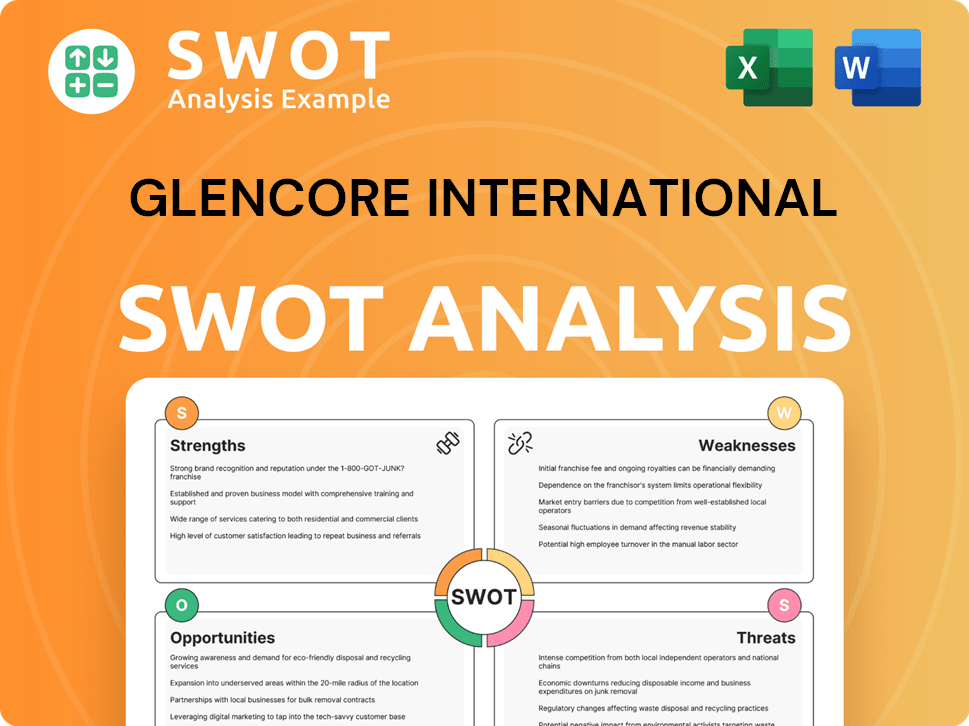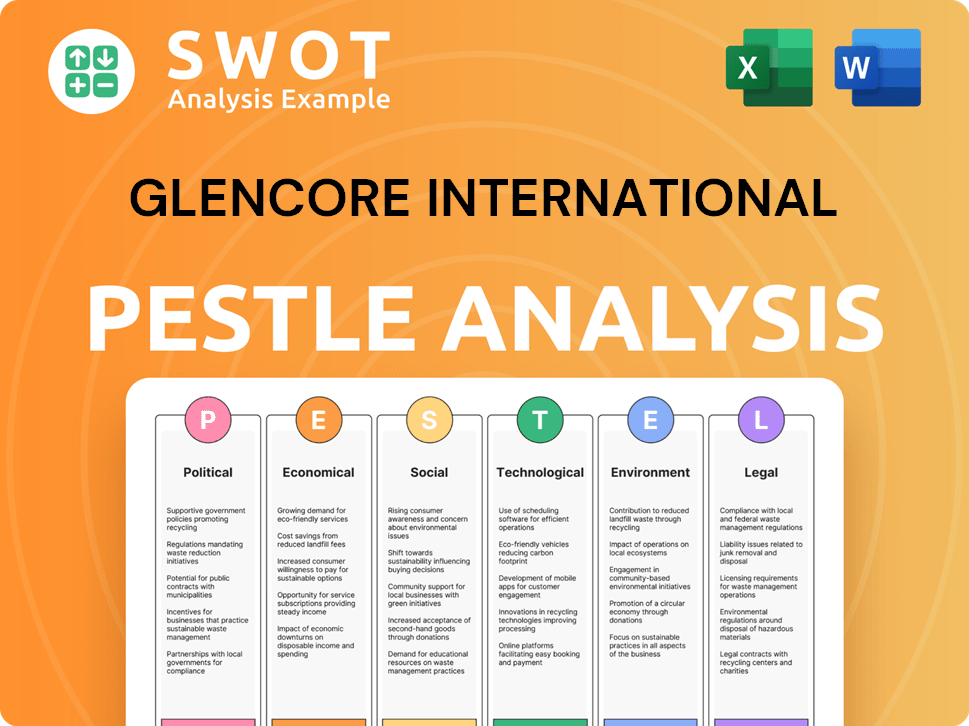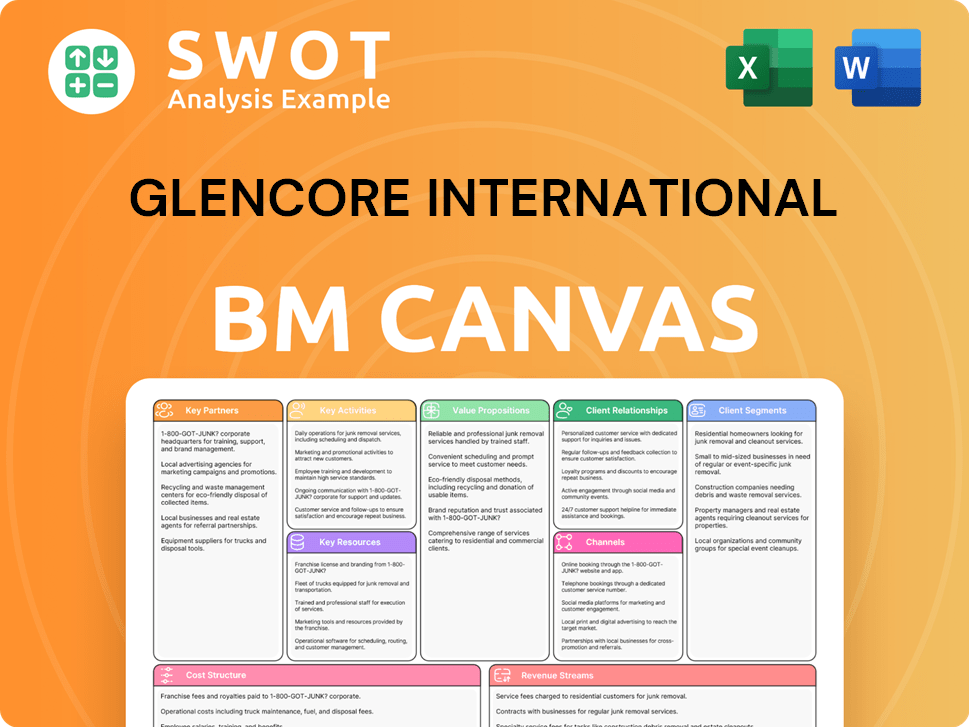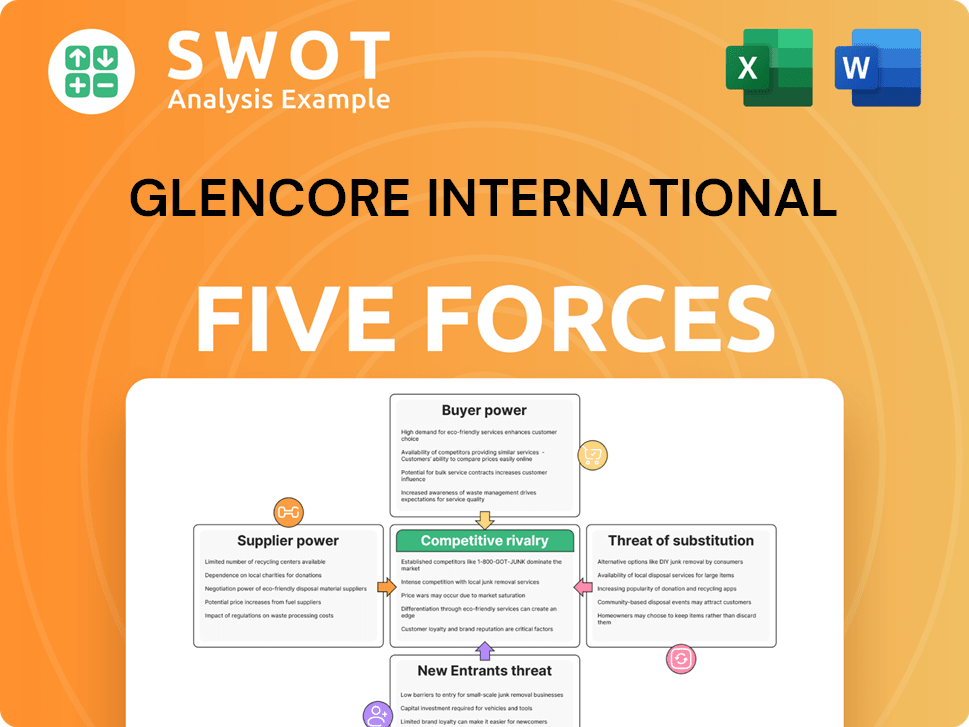Glencore International Bundle
How Does Glencore International Navigate the Global Commodity Landscape?
Glencore International, a Swiss multinational, is a titan in the commodities trading and mining world, but how does it truly operate? This powerhouse, active in over 35 countries, controls a significant portion of the global market for essential resources. Understanding Glencore's Glencore International SWOT Analysis is key to grasping its complex business model and its impact on industries worldwide.

From its vast Glencore operations to its significant role in commodities trading, Glencore's influence is undeniable. Its integrated approach, combining mining assets with trading expertise, sets it apart. Delving into Glencore's financial performance and strategic moves reveals a company adapting to the evolving demands of the global market, particularly in the context of the energy transition.
What Are the Key Operations Driving Glencore International’s Success?
Glencore International creates and delivers value through its integrated business model, spanning the commodity lifecycle from extraction to processing and distribution. This Swiss multinational's core offerings include metals and minerals, energy products, and agricultural products. These commodities serve a broad range of industrial consumers globally. Understanding Glencore operations is key to grasping its market position.
Operational processes are meticulously managed across its global network of offices, mines, and processing facilities. This includes manufacturing, sourcing, logistics, and a sophisticated trading platform. Glencore's supply chain is vertically integrated, with its mining division providing approximately 40% of its traded commodities internally. This vertical integration reduces procurement costs and offers unique market insights, creating margin advantages.
The company's global logistics network further enables cost-effective commodity movements, a crucial advantage in less volatile markets. This integrated model is what sets Glencore apart from competitors, particularly pure trading houses. Its massive scale allows it to manage lower production costs relative to peers, contributing to its cash-generating ability and defensiveness during cyclical downturns. For more insight, explore Owners & Shareholders of Glencore International.
Glencore's primary offerings include metals and minerals such as copper, zinc, nickel, and cobalt. It also deals in energy products like thermal and steelmaking coal, and oil. Agricultural products form another key segment. These commodities are essential for various industries worldwide.
The company manages manufacturing, sourcing, logistics, and a sophisticated trading platform. Vertical integration, with its mining division supplying about 40% of traded commodities, is a key strategy. This approach reduces costs and provides significant market insights.
Glencore's integrated model allows for lower production costs, contributing to its cash-generating ability. Long-standing relationships with producers and consumers provide preferential access to physical commodity flows. This helps maintain trading volumes even when arbitrage opportunities are reduced.
Glencore provides tailored solutions to meet specific customer requirements, maintaining operational excellence and adhering to safety and environmental standards. Investments in advanced technologies, including 3D geological modeling, enhance exploration efficiency and boost productivity. This translates into customer satisfaction and sustainable practices.
Glencore's integrated model and massive scale provide significant advantages in the commodities market. The company's ability to manage lower production costs and maintain strong relationships with producers and consumers are crucial. These factors contribute to its resilience and profitability.
- Vertical Integration: Mining division supplies approximately 40% of traded commodities internally.
- Cost Management: Lower production costs relative to peers enhance cash generation.
- Market Access: Long-standing relationships secure physical commodity flows.
- Technological Advancement: Investments in 3D geological modeling boost efficiency.
Glencore International SWOT Analysis
- Complete SWOT Breakdown
- Fully Customizable
- Editable in Excel & Word
- Professional Formatting
- Investor-Ready Format

How Does Glencore International Make Money?
Understanding how a Swiss multinational, Glencore International, generates revenue is key to grasping its financial structure. The company's operations are centered around a diversified revenue model, primarily driven by commodity sales and trading activities. This approach allows Glencore to navigate the volatile commodities market effectively.
Glencore's business model is designed to capitalize on opportunities across the global commodities market. The company's integrated structure, which includes mining, processing, and marketing, allows it to manage and optimize its revenue streams. This integrated approach is a core element of Glencore's strategy, enabling it to maintain a strong position in the industry.
In 2024, Glencore reported a revenue of US$230.94 billion, showcasing its significant presence in the global market. This robust financial performance underlines the effectiveness of its multifaceted revenue streams and monetization strategies.
Glencore's revenue is generated through several key areas. These include commodity sales from its mining operations, trading profits from its marketing segment, and industrial production from its owned assets. The company also earns revenue from marketing and logistics services, which further diversifies its income sources. To learn more about the company's growth strategies, you can read about the Growth Strategy of Glencore International.
- Commodity Sales: This is a primary source of revenue, derived from the extraction and sale of metals, minerals, energy products, and agricultural products.
- Trading Profits (Marketing Segment): The marketing segment generates income through the buying and selling of physical commodities and commodity derivatives. In 2024, the Marketing Adjusted EBIT was US$3.2 billion. However, the company anticipates a decline in commodity marketing profits in 2025, projecting approximately US$5.2 billion in 2025 trading EBITDA.
- Industrial Production: Revenue is also generated directly from its owned industrial assets, including mines and processing facilities. The Industrial Adjusted EBITDA for 2024 was US$10.6 billion.
- Marketing and Logistics Services: Glencore provides financing, logistics, and other services to producers and consumers of commodities.
Glencore International PESTLE Analysis
- Covers All 6 PESTLE Categories
- No Research Needed – Save Hours of Work
- Built by Experts, Trusted by Consultants
- Instant Download, Ready to Use
- 100% Editable, Fully Customizable

Which Strategic Decisions Have Shaped Glencore International’s Business Model?
Understanding the dynamics of Glencore International involves examining its key milestones, strategic maneuvers, and the competitive advantages that define its operations. As a Swiss multinational, Glencore operates in both commodities trading and as a mining company, playing a significant role in the global market. Its journey is marked by strategic decisions and adaptations to the ever-changing landscape of the commodities sector.
Glencore's evolution showcases its ability to navigate market fluctuations and capitalize on opportunities. From mergers and acquisitions to adjusting its portfolio, the company continuously refines its approach to maintain its position. This analysis provides insights into how Glencore has shaped its operations and financial performance, including its role in commodities trading and its mining operations.
The company's integrated business model, combining mining and trading, is a key element of its success. This strategy provides significant synergies and margin advantages, enabling Glencore to adapt to market changes. The following sections delve into the specifics of these aspects, offering a comprehensive view of Glencore International.
Glencore has several significant milestones that have shaped its trajectory. The merger with Xstrata in 2013 was a pivotal moment, substantially increasing its size and market presence. More recently, the acquisition of 77% of Elk Valley Resources (EVR) in July 2024, a steelmaking coal business, strengthened its position in the coal market.
Strategic moves are critical for Glencore's growth and adaptation. The acquisition of EVR in 2024 contributed US$999 million in EBITDA. Another strategic move in 2024 was the sale of Glencore's share in Viterra to Bunge, leading to a more focused portfolio. These actions highlight Glencore's proactive approach to market dynamics.
Glencore faces operational challenges, including declining trading profits in 2025 due to fading market volatility. Copper production in Q1 2025 saw a 30% year-over-year decline due to operational challenges at key mines. Glencore is recalibrating strategies, targeting approximately US$500 million in operational savings across its trading division.
Glencore's competitive advantages stem from its integrated business model, combining mining and trading. Its massive scale allows for lower production costs compared to peers. The company controls 12% of global copper mining output. Glencore is also investing in technology and data analytics to maintain its competitive edge.
Glencore's operational strategies are continuously evolving to meet market demands. The company's focus on transition-enabling commodities, like copper, zinc, and nickel, is a key strategic move. Glencore's 2024-2026 Climate Action Transition Plan outlines efforts to decarbonize its operational footprint and responsibly phase down thermal coal operations while growing its transition-enabling commodities business. For more insights into Glencore's strategic approach, consider reading about the Growth Strategy of Glencore International.
- The merger with Xstrata in 2013 significantly increased Glencore's market presence.
- The acquisition of 77% of Elk Valley Resources (EVR) in July 2024 strengthened Glencore's position in the coal market, contributing US$999 million in EBITDA in 2024.
- Glencore is adapting to market volatility by diversifying its trading portfolio, including the 2024 acquisition of a lithium trader.
- Copper production in Q1 2025 saw a 30% year-over-year decline, but a strong rebound is expected in H2 2025.
Glencore International Business Model Canvas
- Complete 9-Block Business Model Canvas
- Effortlessly Communicate Your Business Strategy
- Investor-Ready BMC Format
- 100% Editable and Customizable
- Clear and Structured Layout

How Is Glencore International Positioning Itself for Continued Success?
Glencore International holds a prominent position in the global commodity market, functioning as a major producer and marketer of over 60 commodities. It is one of the largest diversified natural resource companies. This Swiss multinational has a substantial presence in the industry, with a significant impact on commodity trading and mining operations worldwide.
The future outlook for Glencore involves strategic initiatives and a balanced approach. The company aims to leverage cash flows from its legacy operations to invest in new projects. It also prioritizes higher-margin segments, such as steelmaking coal. The company is focused on sustainable practices and aims to achieve net-zero industrial CO2e emissions by 2050.
Glencore controls roughly 25% of global seaborne thermal coal and approximately 12% of global copper mining output. Its diversified business model, which combines industrial and marketing activities, is attractive. Glencore International maintains a strong production growth outlook, with a 4% compound annual growth rate in copper-equivalent production expected through 2028.
Market volatility, driven by geopolitical tensions and slowing global growth, poses risks to commodity prices. Climate policies threaten coal assets, and uncertainties exist in cobalt storage solutions. Cost pressures are also a factor, with copper's net unit cash cost rising. The company reported a net loss of US$1.6 billion in 2024, influenced by impairments and one-off charges.
Glencore is focusing on critical minerals recycling, allocating about US$2.8 billion (15% of its 2024 capital expenditure) to projects integrating efficient recycling methods. The company aims for 25% recycled content in its battery-grade metals by 2025. It plans to boost copper production to 1 million tons by 2028. Glencore's operations are also guided by a Climate Action Transition Plan.
The company is investing in new projects and prioritizing higher-margin segments. Glencore is committed to reducing emissions, targeting a 15% reduction by the end of 2026 and a 50% reduction by the end of 2035. Glencore's transition plan aims to achieve net-zero industrial CO2e emissions by 2050. This approach reflects a commitment to sustainable business practices.
Glencore's financial performance includes a net loss of US$1.6 billion in 2024, influenced by impairments and one-off charges. The company's capital expenditure in 2024 included approximately US$2.8 billion allocated to critical minerals recycling projects. Its copper production growth is targeted to reach 1 million tons by 2028.
- 25% of global seaborne thermal coal controlled.
- 12% of global copper mining output controlled.
- 4% compound annual growth rate in copper-equivalent production through 2028.
- 15% emission reduction target by the end of 2026.
Glencore International Porter's Five Forces Analysis
- Covers All 5 Competitive Forces in Detail
- Structured for Consultants, Students, and Founders
- 100% Editable in Microsoft Word & Excel
- Instant Digital Download – Use Immediately
- Compatible with Mac & PC – Fully Unlocked

Related Blogs
- What are Mission Vision & Core Values of Glencore International Company?
- What is Competitive Landscape of Glencore International Company?
- What is Growth Strategy and Future Prospects of Glencore International Company?
- What is Sales and Marketing Strategy of Glencore International Company?
- What is Brief History of Glencore International Company?
- Who Owns Glencore International Company?
- What is Customer Demographics and Target Market of Glencore International Company?
Disclaimer
All information, articles, and product details provided on this website are for general informational and educational purposes only. We do not claim any ownership over, nor do we intend to infringe upon, any trademarks, copyrights, logos, brand names, or other intellectual property mentioned or depicted on this site. Such intellectual property remains the property of its respective owners, and any references here are made solely for identification or informational purposes, without implying any affiliation, endorsement, or partnership.
We make no representations or warranties, express or implied, regarding the accuracy, completeness, or suitability of any content or products presented. Nothing on this website should be construed as legal, tax, investment, financial, medical, or other professional advice. In addition, no part of this site—including articles or product references—constitutes a solicitation, recommendation, endorsement, advertisement, or offer to buy or sell any securities, franchises, or other financial instruments, particularly in jurisdictions where such activity would be unlawful.
All content is of a general nature and may not address the specific circumstances of any individual or entity. It is not a substitute for professional advice or services. Any actions you take based on the information provided here are strictly at your own risk. You accept full responsibility for any decisions or outcomes arising from your use of this website and agree to release us from any liability in connection with your use of, or reliance upon, the content or products found herein.